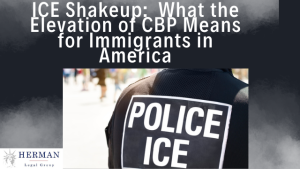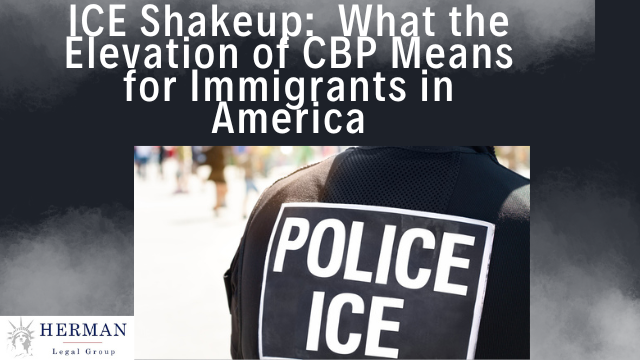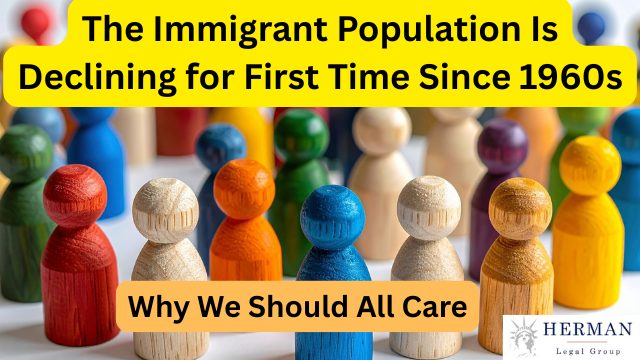What the 2025 Immigration and Customs Enforcement (ICE) Shake-Up Means for Immigrants, Employers, and America’s Future
By Richard T. Herman, Immigration Attorney
In a significant restructuring of federal immigration enforcement, the Trump administration has shifted key responsibilities from Immigration and Customs Enforcement (ICE) to Customs and Border Protection (CBP). This move is part of a major shake up at ICE, involving widespread personnel changes and leadership reassignments across the agency. The scope of these changes underscores the administration’s intent to overhaul ICE’s operations and reflects the political and strategic motivations behind the reorganization.
This shake up at ICE has led to a realignment of enforcement priorities and a reassessment of agency roles, with many officials being removed, reassigned, or replaced in cities nationwide. The impact of these changes is already being felt throughout the immigration system, as both agencies adjust to new directives and expectations.
Introduction: Why This Matters Now
A dramatic restructuring is reshaping America’s immigration-enforcement system in 2025. Reports confirm that U.S. Customs and Border Protection (CBP) is increasingly taking over for U.S. Immigration and Customs Enforcement (ICE) in critical interior-enforcement roles. This reshuffling is occurring alongside efforts to increase enforcement resources, including securing significant funding injections for DHS.
This “ICE shake-up” is more than bureaucratic shuffling—it represents a fundamental reallocation of power within the Department of Homeland Security (DHS).
Fast Fact:
In late October 2025, the Associated Press revealed that at least 12 of ICE’s 25 field-office directors were reassigned, many replaced by current or former CBP officers. These reassignments were among the personnel changes to announce by DHS.
For immigrants, families, and employers—especially in Cleveland and Columbus, Ohio—this reshuffling will redefine how enforcement looks, who shows up at your door, and how cases move through the system.

Customs and Border Protection (CBP) vs Immigration and Customs Enforcement (ICE) — At a Glance
| Function | ICE (Traditional Model) | CBP (New Expanded Role) |
|---|---|---|
| Primary Mission | Interior enforcement & removals | Border security + increasingly interior operations |
| Typical Personnel | Deportation officers & investigators | Border Patrol agents and CBP officers assigned inland |
| Enforcement Focus | Criminal undocumented immigrants & removal orders | Rapid deployment operations, work-site raids, transport oversight |
| Geographic Scope | Entire U.S. interior | Traditionally border zones—now nationwide expansion |
| Legal Authority | INA § 287(g) and related DHS regulations | Same INA authority delegated operationally through DHS |
Expert Tip:
The laws haven’t changed—only the actors. ICE still holds statutory authority under the Immigration and Nationality Act, but CBP officers are now carrying out many of ICE’s on-the-ground duties.
What Triggered the 2025 ICE Shake-Up
The October 2025 Leadership Purge
According to AP News, the DHS directed one of the most sweeping ICE overhauls since 2003, with major personnel changes to announce. Longtime ICE directors in Los Angeles, Chicago, Houston, and Miami were replaced—many by senior border patrol agents, including the appointment of a border patrol commander and a border patrol sector chief in key cities such as San Diego. ICE Director Todd Lyons was among the leaders affected by these personnel changes. Senior officials and ICE officers were reassigned or removed as part of this shake-up, which was widely reported by the Washington Examiner and Fox News. Certain ICE field directors are reported to be removed for underperforming in arrest numbers, as the administration aims to boost deportation numbers and increase ICE’s enforcement and enforcement and removal operations.
Plans are underway to replace some regional leaders at ICE with Border Patrol officials, including senior border patrol agents, to focus on targeted enforcement operations, immigration arrests, and arresting immigrants. ICE has 25 field offices across the country, which are now undergoing significant leadership changes to expand detention capacity and restructure enforcement strategies. The Trump administration is reassigning at least half the top leadership at Immigration and Customs Enforcement offices around the country. Many ICE leaders have expressed criticism towards the aggressive tactics employed by Border Patrol agents in cities.
The Political Driver
The Trump–Vance Administration, led by president donald trump, has prioritized “unity of enforcement” as a central part of president donald trump’s policy agenda. The trump administration’s focus on enforcement has driven significant changes in immigration policy and agency leadership. DHS Secretary Kristi Noem, following a directive from the white house, emphasized a “One Team, One Fight” mission—eliminating what she called ICE’s “bureaucratic drag.” Staff stephen miller and white house deputy chief advisers have been key influencers in this policy shift, ensuring the president’s entire team remains laser focused on achieving the administration’s goals. The administration frames these efforts as fulfilling the american people’s mandate to secure the border and remove criminal illegal aliens.
The reliance on CBP and Border Patrol officials in ICE leadership reflects the view that CBP has been more effective at enforcement, a strategy shaped by border czar tom homan and other trump administration officials. Some Border Patrol officials, including border czar tom homan, have defended tougher enforcement approaches, stating that mass deportations mean “anyone in the US illegally is on the table.”
According to a dhs official cited by fox news, the shift to replace ICE leaders with Border Patrol officials marks a potential new phase in president donald trump’s deportation efforts, especially in the face of resistance from democratic led cities. The integration of CBP tactics into ICE’s enforcement strategy reflects a Department of Homeland Security effort to unify operations under this mission. Additionally, the administration ended the broad use of humanitarian parole, returning it to a case-by-case basis.
The Ohio Connection
Ohio—home to rapidly growing immigrant populations in Cleveland, Columbus, and Dayton—sits at the crossroads of this new enforcement model. CBP teams have reportedly begun joint operations with ICE in Ohio’s industrial corridors and transport hubs, with enforcement actions taking place in locations such as Home Depot parking lots. The Trump administration is increasingly deploying CBP agents far from the border to assist with ICE’s interior enforcement efforts, focusing on arresting immigrants, particularly those caught in the country illegally and unauthorized immigrants.
CBP’s scope, once focused on the border, expanded into cities across the U.S. under the Trump administration, including visible raids and deportation operations. These border patrol’s operations have prioritized immigration arrests, targeting criminal illegal aliens, violent criminal illegal aliens, and removing violent criminal illegal individuals. The goal of deporting criminal illegal aliens remains central, with criminal illegal aliens speak often cited as justification for aggressive enforcement. Tactics during these operations have included the use of tear gas and tear gas canisters, especially during public disturbances and protests. Border Patrol has deployed over 1,500 agents to arrest immigrants in cities across the country. Gregory Bovino, head of Border Patrol operations in Chicago, is accused of using excessive force during immigration enforcement.
Key Insight:
What began as a leadership shuffle is evolving into a merger of enforcement cultures—CBP’s rapid-response style meets ICE’s statutory reach.
Why CBP Is Taking Over
1. Operational Pressure for Higher Removal Numbers
The White House’s 2025 immigration goals call for a 100 percent increase in removals compared to 2023. In line with these objectives, the administration is implementing strategic efforts to boost deportation numbers, focusing on expanding enforcement activities and targeting broader groups of illegal immigrants. CBP’s paramilitary structure allows for faster deployment than ICE’s investigative approach. The administration has also set a goal of 3,000 daily arrests, which ICE has struggled to meet.
2. Cultural Shift Within DHS
CBP emphasizes speed, field presence, and direct action, while ICE traditionally relied on complex investigations. The DHS now favors visible results over case-by-case analysis, reflecting a shift in ICE’s enforcement approach. This new strategy is increasingly driven by border patrol’s tactics, which have included using helicopters and aggressive sweeps to arrest immigrants, distinguishing them from ICE’s previous, more focused operations. Border Patrol agents are accused of using aggressive tactics during immigration enforcement operations, leading to legal disputes over their actions.
3. Policy and Messaging
CBP emphasizes speed, field presence, and direct action, while ICE traditionally relied on complex investigations. The DHS now favors visible results over case-by-case analysis, aligning these changes with the president’s policy agenda and reflecting the view that CBP has been more effective at enforcement.
4. Legal Flexibility
By shifting operational control—without congressional approval—DHS avoids statutory reform. Under existing law, both ICE and CBP may perform removal operations within the United States. The leadership changes at ICE have created internal tension within the Department of Homeland Security. Some ICE officials express concern that the shift to Border Patrol leadership would lead to more aggressive enforcement methods with limited prioritization.
DHS officials stated that the reorganization reflects a division on how best to carry out immigration enforcement. The DHS has reassigned leaders in major cities to increase the focus on immigrants without criminal records, despite ICE’s historical emphasis on criminal aliens. DHS spokesperson Tricia McLaughlin stated that the administration remains focused on removing violent criminal illegal aliens from the country, underscoring the department’s enforcement priorities.
Important Note:
This restructuring could face legal challenges, as advocates argue that interior CBP actions circumvent due process and oversight requirements designed for ICE.
Impact on Enforcement & Removal Operations
Faster Operations, Fewer Safeguards
CBP’s rapid-deployment model means raids and detentions may happen with less notice. Increased detention capacity, supported by expanded resources and funding, enables authorities to detain more individuals at a faster rate. Individuals previously handled by ICE’s scheduled check-ins might now face same-day detention.
Broader Geographic Reach
CBP emphasizes speed, field presence, and direct action, while ICE traditionally relied on complex investigations. The DHS now favors visible results over case-by-case analysis, reflecting the view that CBP has been more effective at enforcement. Border Patrol’s tactics have included using helicopters and aggressive sweeps to arrest immigrants, distinguishing them from ICE’s more focused operations and the recent adoption of targeted enforcement operations as a strategy.
Border Patrol agents are accused of using aggressive tactics during immigration enforcement operations, leading to legal disputes over their actions. In January 2025, DHS rescinded previous guidelines limiting immigration enforcement actions in “sensitive locations” like schools and churches. Protests have erupted in response to aggressive immigration enforcement tactics deployed by federal agents, especially Border Patrol, including the use of tear gas and tear gas canisters for crowd control.
Employer Compliance
Ohio manufacturers and agricultural employers report increased “unannounced visits.” Previously rare for CBP, these visits signal new hybrid enforcement with ICE.
At a Glance: Employers should prepare updated I-9 audits and review compliance protocols with legal counsel.
Local Community Impact
Cleveland and Columbus advocates warn of heightened fear among mixed-status families. Community organizations are launching “Know Your Rights” campaigns modeled after those used during ICE raids in 2019. Heightened fear in immigrant communities due to increased enforcement actions could suppress consumer spending and weaken local tax bases. Increased aggressive tactics by federal agents have caused fears in immigrant communities and raised concerns about racial profiling during enforcement operations.
The decision to reassign ICE directors has led to concerns about the impact on local immigrant communities. Democratic led cities have been particularly resistant to the new enforcement tactics, highlighting ongoing tensions between local governments and federal immigration authorities.
Fast Fact:
The American Immigration Council has documented that aggressive raids correlate with increased PTSD and school absenteeism among immigrant children (immcouncil.org).
Legal Implications for Non-Citizens and Attorneys
Need to Know:
CBP officers are not always trained in the nuances of immigration law. They often apply border procedures to interior cases—raising concerns over due process.
For Non-Criminal Immigrants
- Increased risk of arrest without warrants, especially for those caught in the country illegally.
- Shorter timelines between arrest and removal.
- Possible misclassification of status holders (e.g., pending asylum cases).
For Attorneys
- Defense strategies must adapt to CBP’s limited discretion on prosecutorial deference.
- Expect new documentation requirements and contact points for CBP-initiated cases.
- More coordination between immigration litigation and federal civil-rights teams.
Expert Tip
Ohio immigration lawyers should establish direct liaisons with CBP’s regional offices and stay informed of joint ICE/CBP protocols posted on cbp.gov.
Regional Focus: Cleveland and Columbus Ohio
Why It Matters Here
Ohio hosts over 550,000 foreign-born residents, many in industries now subject to increased scrutiny. Local advocates report that ice officers, along with CBP officers, have been seen assisting ICE in routine compliance visits across Northeast Ohio. Increased deportation and enforcement efforts are expected to worsen labor shortages in industries such as agriculture, construction, hospitality, and manufacturing. A study projected that millions of workers could be lost by 2035 if current enforcement continues. Labor shortages due to increased enforcement are likely to force employers to raise wages, increasing operational costs.
Community Response
Faith-based and nonprofit groups in Cleveland and Columbus are forming rapid-response networks to document CBP encounters and connect families with attorneys immediately after detention.
Key Insight:
In practice, CBP’s arrival on Ohio streets means immigration law no longer stops at the border.
Law Firms Experienced in ICE/CBP Matters
1. Herman Legal Group – Cleveland & Columbus | Nationwide Representation
Founded in Cleveland, the Herman Legal Group has served immigrants for over 30 years. We handle removal defense, ICE audits, and now CBP interior enforcement matters nationwide. Our team speaks 10+ languages and represents clients in all 50 states.
2. Fragomen Worldwide
A global leader in corporate immigration compliance and government relations (fragomen.com). Often consulted by multinational employers on worksite enforcement.
3. Berry Appleman & Levine (BAL)
Renowned U.S. immigration boutique (bal.com) specializing in high-volume corporate immigration and enforcement response planning.
4. Greenberg Traurig LLP
Full-service national firm (gtlaw.com) with a dedicated immigration practice for employers and foreign professionals.
5. Cohen & Grigsby (PGH)
Respected Pennsylvania-based firm (cohenlaw.com) offering strong removal defense and corporate compliance counsel nationwide.
Expert Tip:
When choosing representation, ask the firm, “Have you handled cases where CBP—not ICE—led the enforcement action?” The answer will reveal their current readiness.
What to Watch Next
- Policy Memos: Expect new DHS guidance on CBP/ICE coordination by early 2026, with federal officials responsible for implementing these new policies.
- Budget Changes: Congress may reallocate funds toward CBP’s interior enforcement divisions, with federal officials overseeing the operational changes.
- Legal Challenges: Civil-rights groups are preparing litigation questioning CBP’s expanded jurisdiction, which is being enforced by federal officials.
- Ohio Community Response: Local governments may reassess cooperation agreements with federal agents and federal officials.
Key Insight:
The ICE shake-up is not temporary—it marks a major shake up in immigration enforcement, representing a structural realignment likely to define immigration enforcement for the next decade.
Conclusion
The decision to place CBP at the forefront of immigration enforcement reflects a philosophical shift in how America handles its immigrant population. It blurs the lines between border and interior, civil and criminal, human and bureaucratic. The Trump administration plans to integrate Border Patrol leadership into ICE operations to enhance immigration enforcement, with these changes being implemented by the president’s entire team.
For immigrants in Ohio and across the United States, the message is clear: be informed, be represented, and be prepared. Legal advice is no longer optional—it’s essential.
As an immigration attorney with three decades of experience, I urge families and employers to seek guidance now before a CBP officer knocks instead of an ICE agent.
Key Takeaways
- CBP’s expansion into ICE roles marks the largest DHS restructuring since 2003.
- A major shake up at ICE: At least 12 ICE directors were replaced by CBP officials in October 2025 (AP News).
- The change prioritizes speed and visibility over investigation depth.
- Non-criminal immigrants face heightened risk of arrest and rapid removal.
- Employers must strengthen I-9 and E-Verify compliance protocols.
- Ohio communities (Cleveland & Columbus) will see more CBP-led worksite visits.
- Legal representation is critical—Herman Legal Group leads the field in CBP/ICE transition defense.
- Expect further DHS policy memos and court challenges through 2026.








